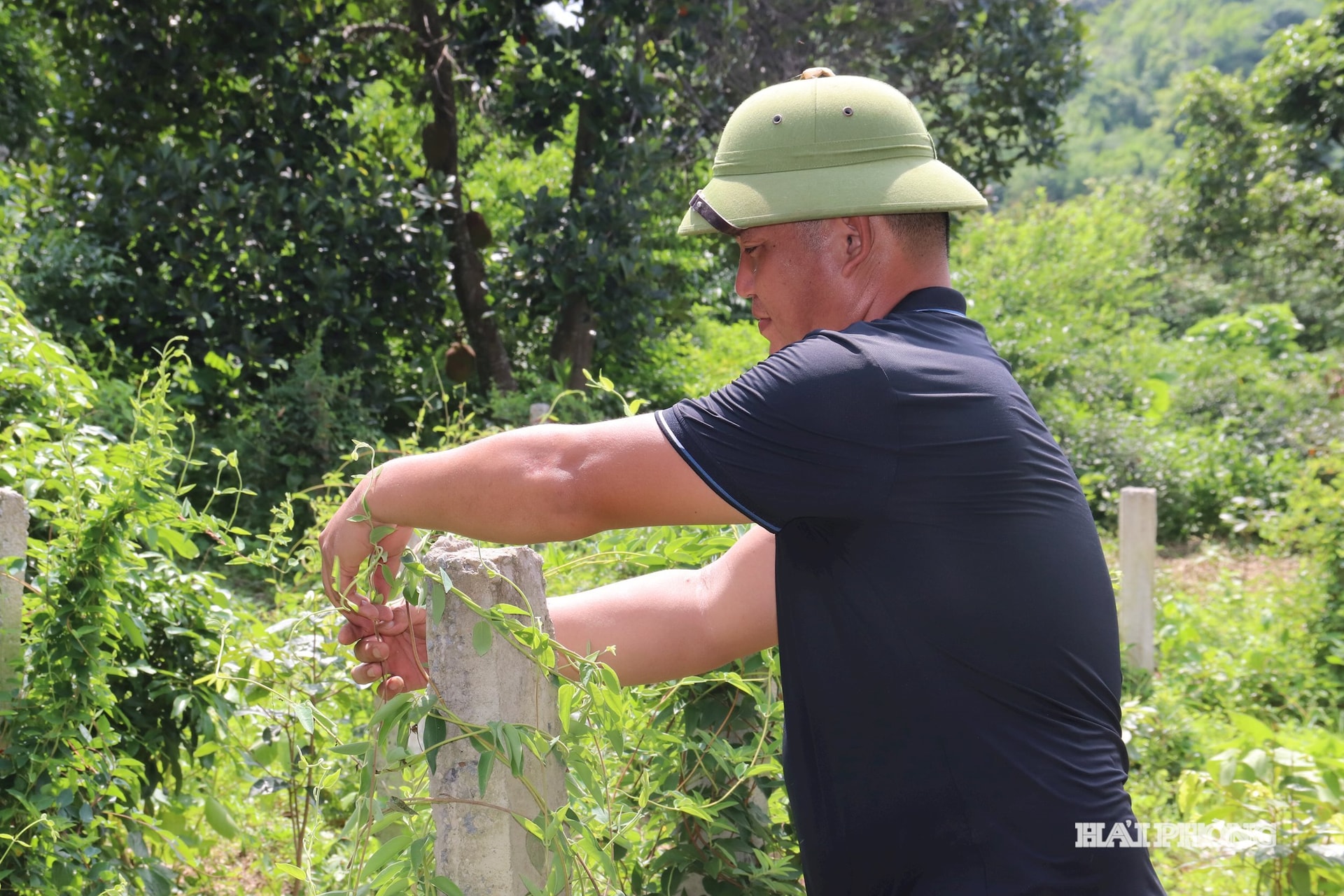
Creating a new look for the countryside
Previously, medicinal plants only appeared sporadically in home gardens, mainly for family needs or retail. Currently, with the increasing demand for medicinal plants in drug research and processing along with export, many localities have considered medicinal plants as key crops to replace ineffective agricultural crops. Many medicinal plants have high and stable incomes such as: Polyscias fruticosa with an income of 200 to 300 million VND/ha/year; Purple cardamom: 250 to 400 million VND/ha/year; Purple Morinda officinalis: 150 to 250 million VND/ha/year...
Operating since 2011, Dong Bac Medicinal Herbs Cultivation, Production and Processing Limited Liability Company (Son Hai village, Hai Hoa commune, Quang Ninh province) focuses on researching climate and soil conditions as well as farming practices of local households and bringing in experimental planting of some medicinal plants such as: Gynostemma pentaphyllum, Solanum procumbens, Gymnema sylvestre, Phyllanthus urinaria, Vằng tea, Chinese yam... Up to now, all raw materials are closely monitored by the company from seed production to planting, care and harvesting, ensuring quality safety.
In addition to investing in irrigation systems, roofs, and applying new technology to increase productivity, the company has expanded its raw material areas, combined with cooperatives, transferred planting and care techniques to households in the form of hand-holding and implementation of product consumption for growers. Currently, in addition to the specialized raw material area of nearly 10 hectares, the company has expanded the growing area in households to about 20 hectares, helping people have a source of income 6 to 10 times higher than growing food crops.
Not only Quang Ninh, many mountainous provinces such as Lao Cai, Son La or delta provinces such as Ninh Binh, Hung Yen , etc. are also forming specialized areas for growing medicinal plants to replace food crops.
In Lao Cai, artichoke is considered a “golden tree” as it brings in hundreds of billions of dong in revenue each year for businesses and farmers. Cinnamon and star anise have become sustainable “rich trees” in many mountainous provinces. Shifting the crop structure associated with medicinal herbs is considered a strategic direction by many localities.
Statistics show that the country currently has over 5,000 species of medicinal plants, of which about 300 species with high economic value have been exploited, cultivated and commonly used. It is estimated that the Vietnamese medicinal market needs about 60 to 80 thousand tons each year, but domestic supply can only meet 25 to 30%. This is a large area for scientists, businesses and people to develop.

Need cooperation
According to Deputy Minister of Health Do Xuan Tuyen, Vietnam has great potential to develop medicinal herbs, but to transform that potential, many challenges need to be resolved.
Currently, the planning of medicinal plant growing areas is not uniform, still fragmented, small-scale, difficult to apply high technology, and has not created a closed value chain. Most people are familiar with growing rice, corn, cassava, etc., so when switching to growing medicinal plants, they lack knowledge and experience. Medicinal plants require strict planting, care, and harvesting processes, requiring high techniques, and people are at risk if they do not follow the correct process.
On the other hand, the number of enterprises processing and consuming products for people is still small; this value chain is not really sustainable, the four-party linkage model (State, scientists, enterprises and people) has been formed but is not tight. In particular, the situation of medicinal materials of unknown origin and not guaranteed quality still exists, causing difficulties for domestic medicinal materials...
Medicinal plants are plants with very strict requirements in cultivation techniques, however, farmers have not been transferred the technique of planting seedlings, harvesting and processing, mostly based on word of mouth experience. In addition, the exploitation of natural medicinal plants is still widespread, harvesting without paying attention to conservation and regeneration; there is no coordination in the research and development of medicinal plants between the health and agricultural sectors, leading to a shortage of raw materials and not ensuring quality.
Managing the origin of exploited medicinal herbs is still difficult, requiring coordination between ministries and branches to ensure that medicinal herbs circulating on the market have clear origin and source.
At the recent conference to review 5 years of implementing the program of developing traditional medicine combined with modern medicine, many opinions said that there should be specific support policies to create breakthroughs for Vietnamese medicinal herbs.
Accordingly, the State needs to plan medicinal plant growing areas; create incentive mechanisms and policies; promote the transfer of planting, care, processing and preservation techniques; and at the same time build a chain linking the production and consumption of medicinal plants between people and businesses.
It is especially necessary to have the joint efforts of four parties, in which enterprises play a key role in connecting scientists, supporting medicinal plant growers; organizing training, building technology transfer models, applying high technology in planting, harvesting medicinal plants and producing finished products. There needs to be a solution to strictly control the import of medicinal plants of unknown origin for production purposes.
To develop medicinal herbs sustainably, it is necessary to plan concentrated planting areas in line with the advantages of each locality, especially indigenous and endemic species, to avoid the situation of mass planting following trends leading to surplus and devaluation. In addition, it is necessary to participate in the global supply chain, instead of exporting raw materials across borders.
Source: https://baohaiphong.vn/huong-di-ben-vung-cho-cay-duoc-lieu-522000.html



![[Photo] General Secretary To Lam receives US Ambassador to Vietnam Marc Knapper](https://vphoto.vietnam.vn/thumb/1200x675/vietnam/resource/IMAGE/2025/9/29/c8fd0761aa184da7814aee57d87c49b3)
![[Photo] General Secretary To Lam chairs the meeting of the Central Steering Committee on preventing and combating corruption, waste and negativity](https://vphoto.vietnam.vn/thumb/1200x675/vietnam/resource/IMAGE/2025/9/29/fb2a8712315d4213a16322588c57b975)
![[Photo] General Secretary To Lam attends the ceremony to celebrate the 80th anniversary of the post and telecommunications sector and the 66th anniversary of the science and technology sector.](https://vphoto.vietnam.vn/thumb/1200x675/vietnam/resource/IMAGE/2025/9/29/8e86b39b8fe44121a2b14a031f4cef46)
![[Photo] Many streets in Hanoi were flooded due to the effects of storm Bualoi](https://vphoto.vietnam.vn/thumb/1200x675/vietnam/resource/IMAGE/2025/9/29/18b658aa0fa2495c927ade4bbe0096df)
![[Photo] National Assembly Chairman Tran Thanh Man chairs the 8th Conference of full-time National Assembly deputies](https://vphoto.vietnam.vn/thumb/1200x675/vietnam/resource/IMAGE/2025/9/29/2c21459bc38d44ffaacd679ab9a0477c)

































































































Comment (0)